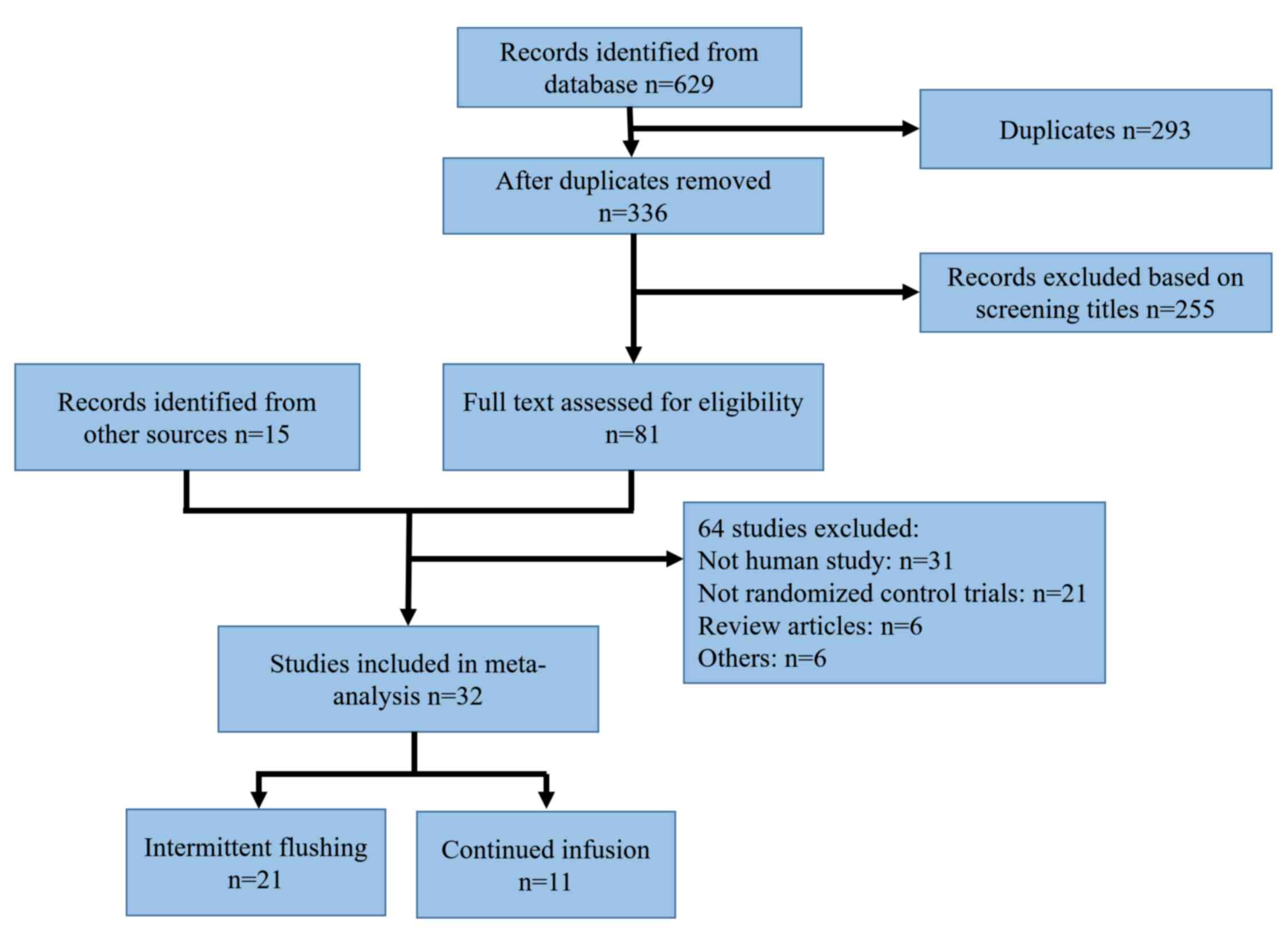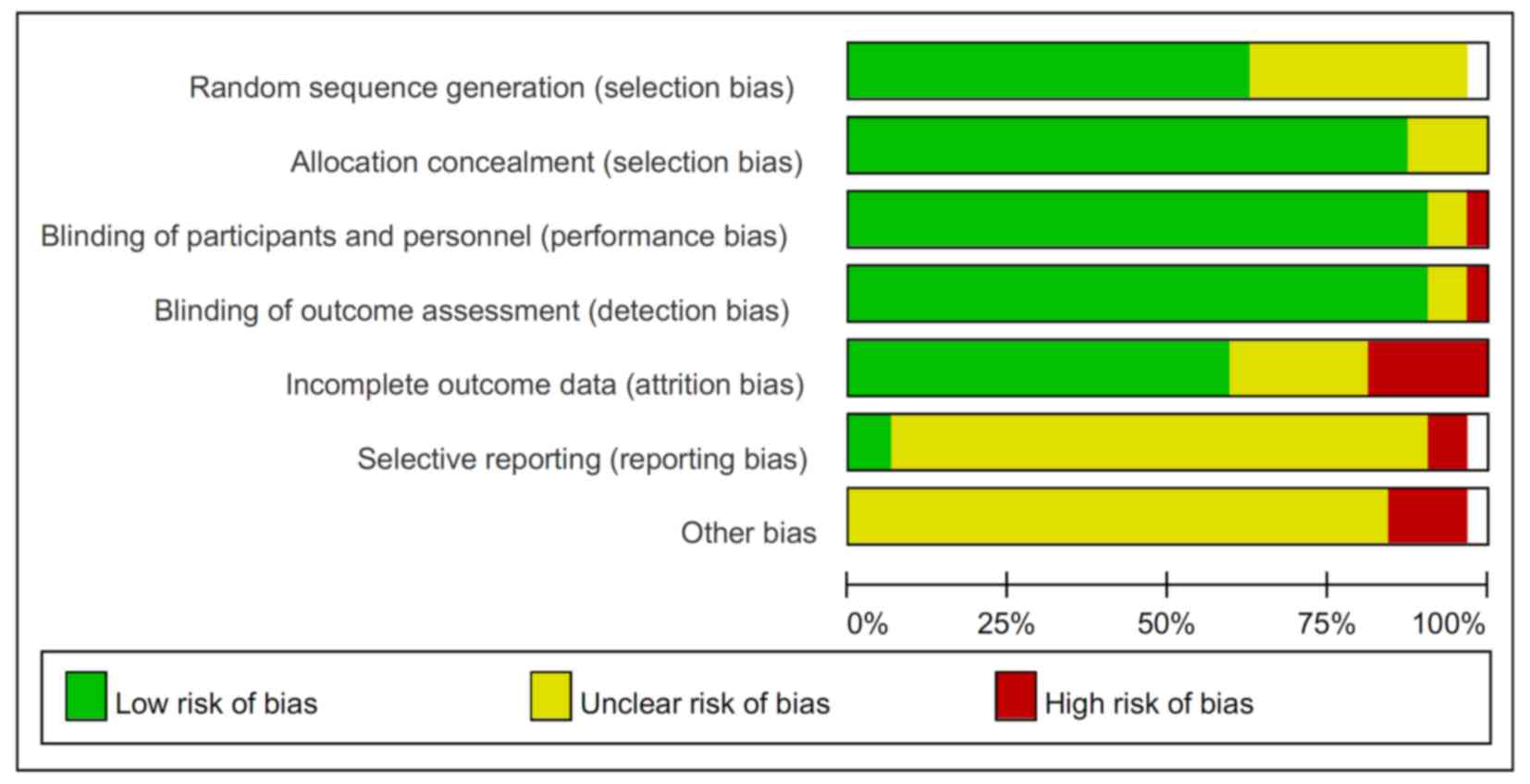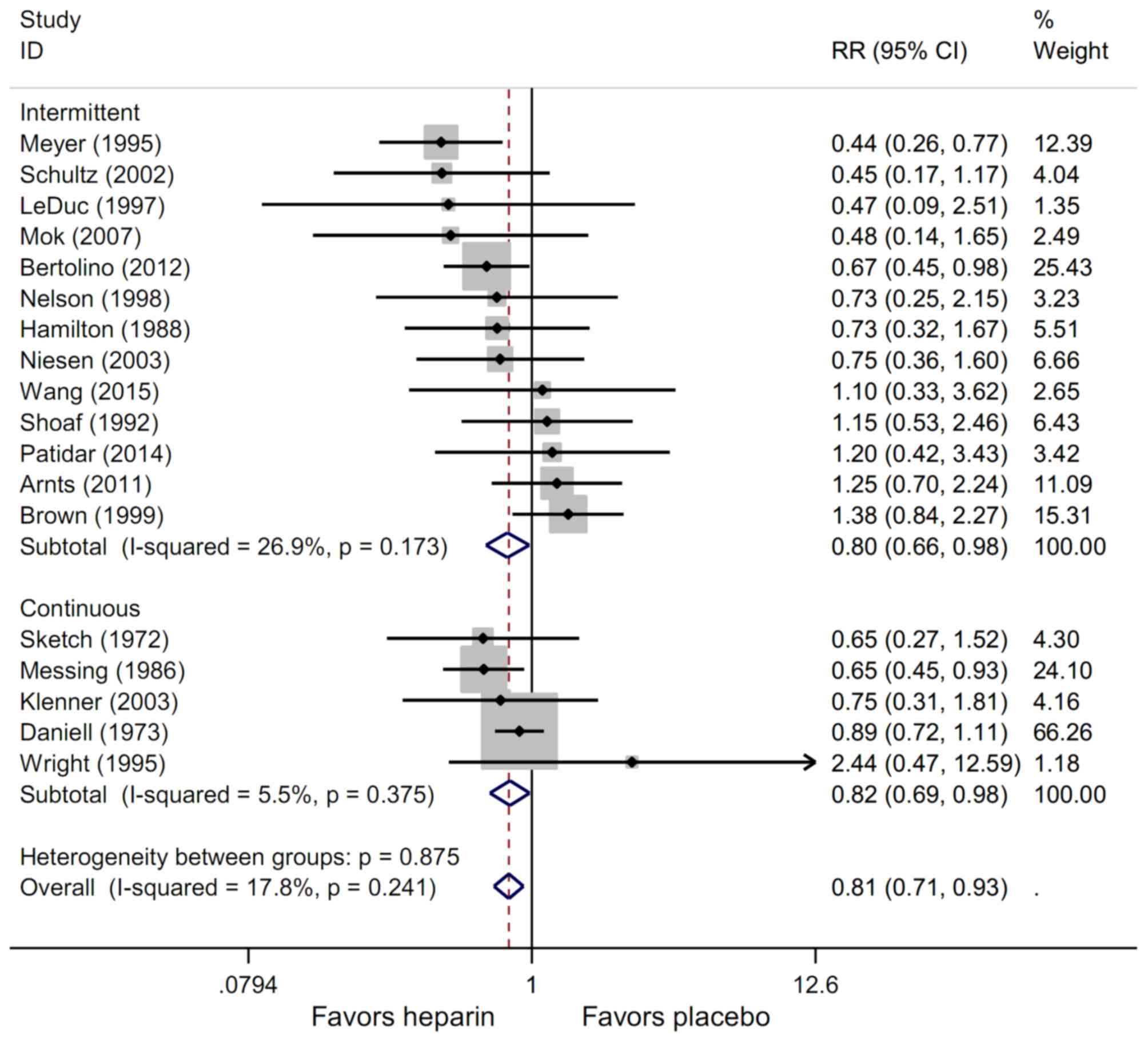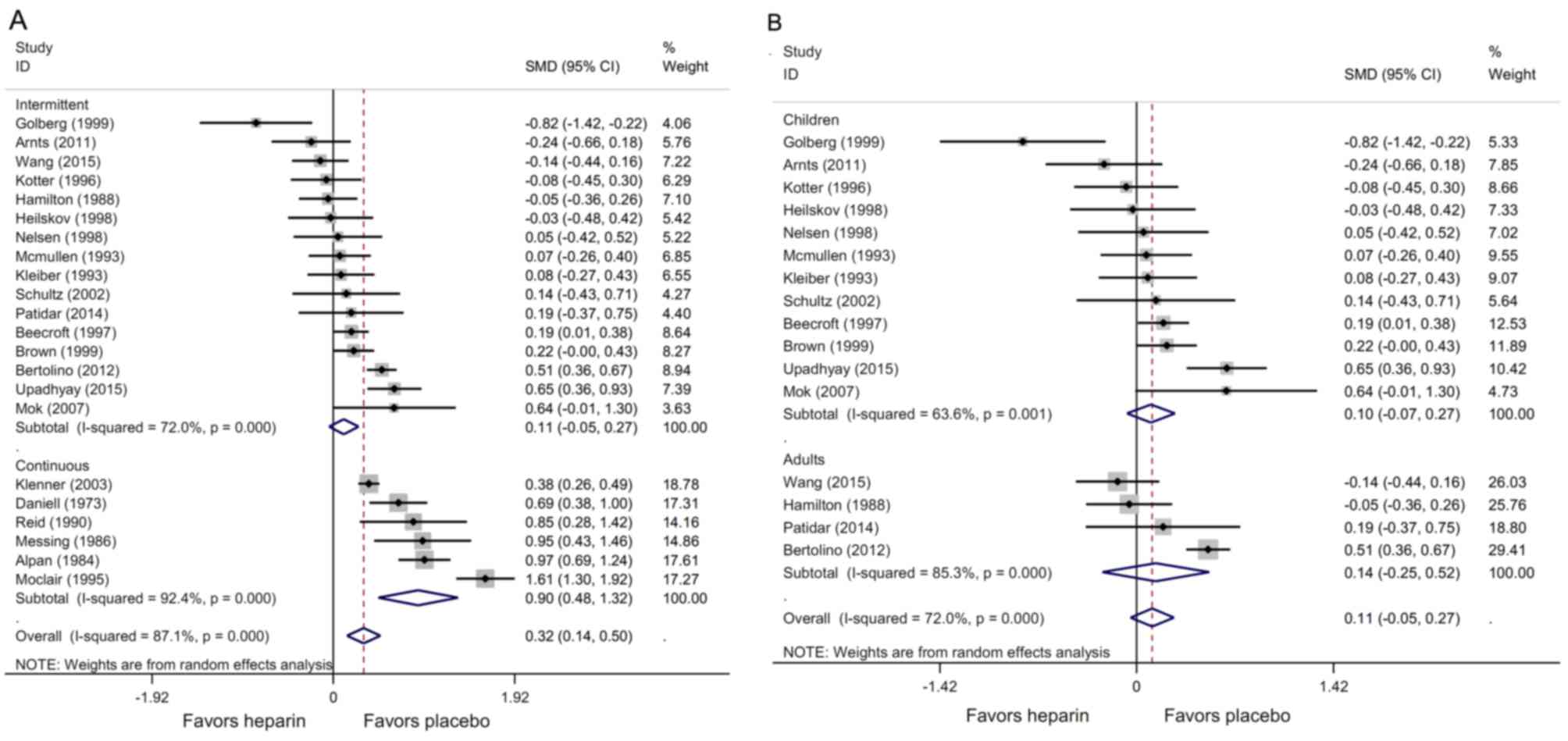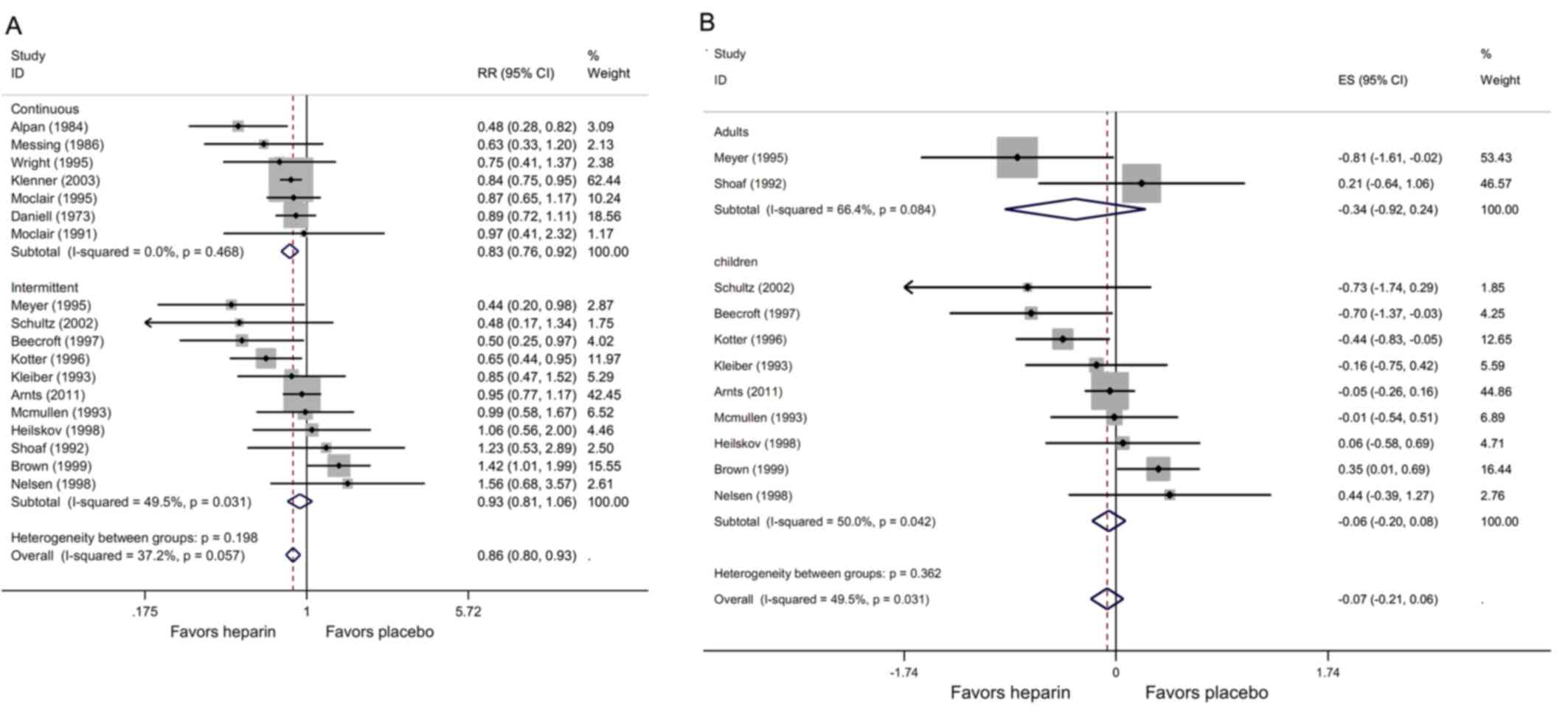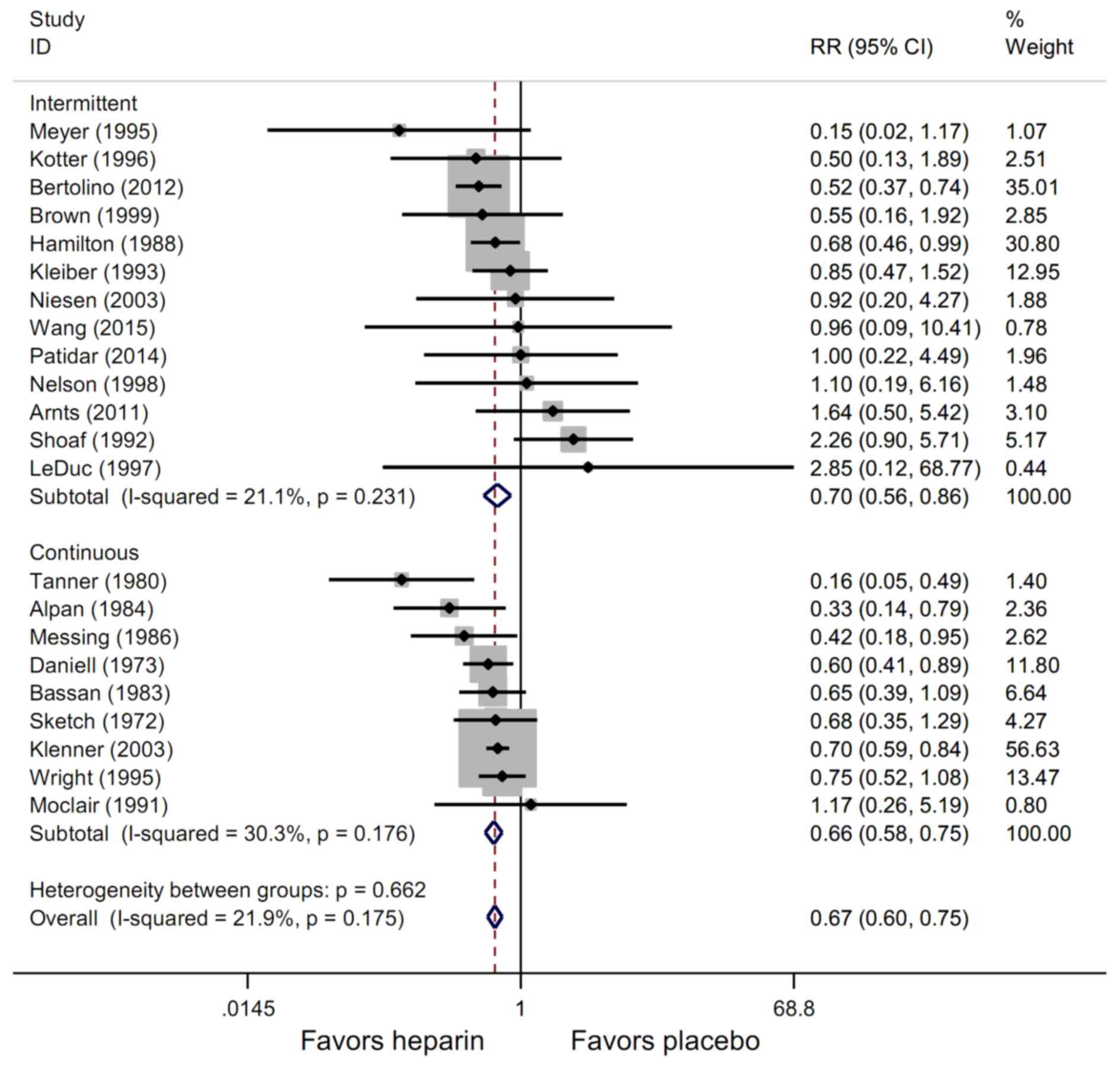|
1
|
Shah PS and Shah VS: Continuous heparin
infusion to prevent thrombosis and catheter occlusion in neonates
with peripherally placed percutaneous central venous catheters.
Cochrane Database Syst Rev: CD002772. 2008. View Article : Google Scholar
|
|
2
|
Unal S, Ekici F, Cetin II and Bilgin L:
Heparin infusion to prevent umbilical venous catheter related
thrombosis in neonates. Thromb Res. 130:725–728. 2012. View Article : Google Scholar : PubMed/NCBI
|
|
3
|
Kumar M, Vandermeer B, Bassler D and
Mansoor N: Low-dose heparin use and the patency of peripheral IV
catheters in children: A systematic review. Pediatrics.
131:e864–e872. 2013. View Article : Google Scholar : PubMed/NCBI
|
|
4
|
Randolph AG, Cook DJ, Gonzales CA and
Andrew M: Benefit of heparin in peripheral venous and arterial
catheters: Systematic review and meta-analysis of randomised
controlled trials. BMJ. 316:969–975. 1998. View Article : Google Scholar : PubMed/NCBI
|
|
5
|
Yau JW, Stafford AR, Liao P, Fredenburgh
JC, Roberts R and Weitz JI: Mechanism of catheter thrombosis:
Comparison of the antithrombotic activities of fondaparinux,
enoxaparin, and heparin in vitro and in vivo. Blood. 118:6667–6674.
2011. View Article : Google Scholar : PubMed/NCBI
|
|
6
|
Daniell HW: Heparin prevention of catheter
thrombosis. JAMA. 216:12001971. View Article : Google Scholar : PubMed/NCBI
|
|
7
|
Niesen KM, Harris DY, Parkin LS and Henn
LT: The effects of heparin versus normal saline for maintenance of
peripheral intravenous locks in pregnant women. J Obstet Gynecol
Neonatal Nurs. 32:503–508. 2003. View Article : Google Scholar : PubMed/NCBI
|
|
8
|
Hamilton RA, Plis JM, Clay C and Sylvan L:
Heparin sodium versus 0.9% sodium chloride injection for
maintaining patency of indwelling intermittent infusion devices.
Clin Pharm. 7:439–443. 1988.PubMed/NCBI
|
|
9
|
Shoaf J and Oliver S: Efficacy of normal
saline injection with and without heparin for maintaining
intermittent intravenous site. Appl Nurs Res. 5:9–12. 1992.
View Article : Google Scholar : PubMed/NCBI
|
|
10
|
Robertson-Malt S, Malt GN, Farquhar V and
Greer W: Heparin versus normal saline for patency of arterial
lines. Cochrane Database Syst Rev: CD007364. 2014. View Article : Google Scholar
|
|
11
|
Lopez-Briz E, Garcia V Ruiz, Cabello JB,
Bort-Marti S, Sanchis R Carbonell and Burls A: Heparin versus 0.9%
sodium chloride intermittent flushing for prevention of occlusion
in central venous catheters in adults. Cochrane Database Syst Rev:
CD008462. 2014. View Article : Google Scholar
|
|
12
|
Kumar M, Vandermeer B, Bassler D and
Mansoor N: Low-dose heparin for prolonging the patency of
peripheral intravenous catheters in adults - a systematic review
and meta-analysis. Int J Med. 2:13–21. 2014. View Article : Google Scholar
|
|
13
|
Ahmed I, Majeed A and Powell R: Heparin
induced thrombocytopenia: Diagnosis and management update. Postgrad
Med J. 83:575–582. 2007. View Article : Google Scholar : PubMed/NCBI
|
|
14
|
Kleiber C, Hanrahan K, Fagan CL and
Zittergruen MA: Heparin vs. saline for peripheral i.v. locks in
children. Pediatr Nurs. 19:405–409, 376. 1993.PubMed/NCBI
|
|
15
|
Upadhyay A, Verma KK, Lal P, Chawla D and
Sreenivas V: Heparin for prolonging peripheral intravenous catheter
use in neonates: A randomized controlled trial. J Perinatol.
35:274–277. 2015. View Article : Google Scholar : PubMed/NCBI
|
|
16
|
Wang R, Zhang MG, Luo O, He L, Li JX, Tang
YJ, Luo YL, Zhou M, Tang L, Zhang ZX, et al: Heparin saline versus
normal saline for flushing and locking peripheral venous catheters
in decompensated liver cirrhosis patients: A randomized controlled
trial. Medicine (Baltimore). 94:e12922015. View Article : Google Scholar : PubMed/NCBI
|
|
17
|
Bertolino G, Pitassi A, Tinelli C,
Staniscia A, Guglielmana B, Scudeller L and Balduini C Luigi:
Intermittent flushing with heparin versus saline for maintenance of
peripheral intravenous catheters in a medical department: A
pragmatic cluster-randomized controlled study. Worldviews Evid
Based Nurs. 9:221–226. 2012. View Article : Google Scholar : PubMed/NCBI
|
|
18
|
Higgins JP, Altman DG, Gøtzsche PC, Jüni
P, Moher D, Oxman AD, Savovic J, Schulz KF, Weeks L, Sterne JA, et
al: The Cochrane Collaboration's tool for assessing risk of bias in
randomised trials. BMJ. 343:d59282011. View Article : Google Scholar : PubMed/NCBI
|
|
19
|
Moher D, Liberati A, Tetzlaff J and Altman
DG; PRISMA Group, : Preferred reporting items for systematic
reviews and meta-analyses: The PRISMA statement. PLoS Med.
6:e10000972009. View Article : Google Scholar : PubMed/NCBI
|
|
20
|
Meyer BA, Little CJ, Thorp JA, Cohen GR
and Yeast JD: Heparin versus normal saline as a peripheral line
flush in maintenance of intermittent intravenous lines in obstetric
patients. Obstet Gynecol. 85:433–436. 1995. View Article : Google Scholar : PubMed/NCBI
|
|
21
|
Mok E, Kwong TK and Chan MF: A randomized
controlled trial for maintaining peripheral intravenous lock in
children. Int J Nurs Pract. 13:33–45. 2007. View Article : Google Scholar : PubMed/NCBI
|
|
22
|
Arnts IJ, Heijnen JA, Wilbers HT, van der
Wilt GJ, Groenewoud JM and Liem KD: Effectiveness of heparin
solution versus normal saline in maintaining patency of intravenous
locks in neonates: A double blind randomized controlled study. J
Adv Nurs. 67:2677–2685. 2011. View Article : Google Scholar : PubMed/NCBI
|
|
23
|
Kotter RW: Heparin vs saline for
intermittent intravenous device maintenance in neonates. Neonatal
Netw. 15:43–47. 1996.PubMed/NCBI
|
|
24
|
Beecroft PC, Bossert E, Chung K, Greene
CV, Johnson LC, Jury D, Kent Y, O'Byrne C, Powell SL and Sperhac
AM: Intravenous lock patency in children: dilute heparin versus
saline. J Pediatr Pharm Pract. 2:211–223. 1997.
|
|
25
|
Brown K, Tay-Uyboco JS and McMillan DD:
Heparin is not required for peripheral intravenous locks in
neonates. Paediatr Child Health. 4:39–42. 1999.PubMed/NCBI
|
|
26
|
Heilskov J, Kleiber C, Johnson K and
Miller J: A randomized trial of heparin and saline for maintaining
intravenous locks in neonates. J Soc Pediatr Nurs. 3:111–116. 1998.
View Article : Google Scholar : PubMed/NCBI
|
|
27
|
Nelson TJ and Graves SM: 0.9% sodium
chloride injection with and without heparin for maintaining
peripheral indwelling intermittent-infusion devices in infants. Am
J Health Syst Pharm. 55:570–573. 1998.PubMed/NCBI
|
|
28
|
Schultz AA, Drew D and Hewitt H:
Comparison of normal saline and heparinized saline for patency of
IV locks in neonates. Appl Nurs Res. 15:28–34. 2002. View Article : Google Scholar : PubMed/NCBI
|
|
29
|
Golberg M, Sankaran R, Givelichan L and
Sankaran K: Maintaining patency of peripheral intermittent infusion
devices with heparinized saline and saline. Neonatal Intensive
Care. 12:18–22. 1999.
|
|
30
|
Ashton J, Gibson V and Summers S: Effects
of heparin versus saline solution on intermittent infusion device
irrigation. Heart Lung. 19:608–612. 1990.PubMed/NCBI
|
|
31
|
Patidar AB, Choudhary M, Bindu K and Midha
V: Comparative efficacy of heparin saline and normal saline flush
for maintaining patency of peripheral intravenous lines: A
randomized control trial. IJHSR. 4:159–166. 2014.
|
|
32
|
LeDuc K: Efficacy of normal saline
solution versus heparin solution for maintaining patency of
peripheral intravenous catheters in children. J Emerg Nurs.
23:306–309. 1997. View Article : Google Scholar : PubMed/NCBI
|
|
33
|
McMullen A, Fioravanti ID, Pollack V,
Rideout K and Sciera M: Heparinized saline or normal saline as a
flush solution in intermittent intravenous lines in infants and
children. MCN Am J Matern Child Nurs. 18:78–85. 1993. View Article : Google Scholar : PubMed/NCBI
|
|
34
|
Tanner WA, Delaney PV and Hennessy TP: The
influence of heparin on intravenous infusions: A prospective study.
Br J Surg. 67:311–312. 1980. View Article : Google Scholar : PubMed/NCBI
|
|
35
|
Daniell HW: Heparin in the prevention of
infusion phlebitis. A double-blind controlled study. JAMA.
226:1317–1321. 1973. View Article : Google Scholar : PubMed/NCBI
|
|
36
|
Messing B, Leverve X, Rigaud D, Krummel Y,
Botta D, Latarget J, Mudry P and Guignier M: Peripheral venous
complications of a hyperosmolar (960 mOsm) nutritive mixture: The
effect of heparin and hydrocortisone. A multicenter double-blinded
random study in 98 patients. Clin Nutr. 5:57–61. 1986. View Article : Google Scholar : PubMed/NCBI
|
|
37
|
Alpan G, Eyal F, Springer C, Glick B,
Goder K and Armon J: Heparinization of alimentation solutions
administered through peripheral veins in premature infants: A
controlled study. Pediatrics. 74:375–378. 1984.PubMed/NCBI
|
|
38
|
Klenner AF, Fusch C, Rakow A, Kadow I,
Beyersdorff E, Eichler P, Wander K, Lietz T and Greinacher A:
Benefit and risk of heparin for maintaining peripheral venous
catheters in neonates: A placebo-controlled trial. J Pediatr.
143:741–745. 2003. View Article : Google Scholar : PubMed/NCBI
|
|
39
|
Moclair A and Bates I: The efficacy of
heparin in maintaining peripheral infusions in neonates. Eur J
Pediatr. 154:567–570. 1995. View Article : Google Scholar : PubMed/NCBI
|
|
40
|
Moclair AE, Moselhi M, Benjamin IS and
Hecker JF: Total parenteral nutrition via a peripheral vein: A
comparison of heparinised and non-heparinised regimens. Int J Pharm
Pract. 1:38–40. 1991. View Article : Google Scholar
|
|
41
|
Reid I, Keane FBV, Monson JRT and Tanner
WA: Thrombophlebitis following peripherally administered parenteral
nutrition-A randomized clinical study of the effect of infusion
additives. Surg Res Commun. 9:69–77. 1990.
|
|
42
|
Bassan MM and Sheikh-Hamad D: Prevention
of lidocaine-infusion phlebitis by heparin and hydrocortisone.
Chest. 84:439–441. 1983. View Article : Google Scholar : PubMed/NCBI
|
|
43
|
Sketch MH, Cale M, Mohiuddin SM and Booth
RW: Use of percutaneously inserted venous catheters in coronary
care units. Chest. 62:684–689. 1972. View Article : Google Scholar : PubMed/NCBI
|
|
44
|
Wright A, Hecker J and McDonald G: Effects
of low-dose heparin on failure of intravenous infusions in
children. Heart Lung. 24:79–82. 1995. View Article : Google Scholar : PubMed/NCBI
|
|
45
|
Anderson AJ, Krasnow SH, Boyer MW,
Raucheisen ML, Grant CE, Gasper OR, Hoffmann JK and Cohen MH:
Hickman catheter clots: A common occurrence despite daily heparin
flushing. Cancer Treat Rep. 71:651–653. 1987.PubMed/NCBI
|
|
46
|
Goode CJ, Titler M, Rakel B, Ones DS,
Kleiber C, Small S and Triolo PK: A meta-analysis of effects of
heparin flush and saline flush: Quality and cost implications. Nurs
Res. 40:324–330. 1991. View Article : Google Scholar : PubMed/NCBI
|
|
47
|
Peterson FY and Kirchhoff KT: Analysis of
the research about heparinized versus nonheparinized intravascular
lines. Heart Lung. 20:631–640. 1991.PubMed/NCBI
|
|
48
|
Brodin-Sartorius A, Martinez F and
Legendre C: Treatment of superficial thrombophlebitis. N Engl J
Med. 364:380–381. 2011. View Article : Google Scholar : PubMed/NCBI
|
|
49
|
Tyrrell DJ, Horne AP, Holme KR, Preuss JM
and Page CP: Heparin in inflammation: Potential therapeutic
applications beyond anticoagulation. Adv Pharmacol. 46:151–208.
1999. View Article : Google Scholar : PubMed/NCBI
|
|
50
|
Folwaczny C, Wiebecke B and Loeschke K:
Unfractioned heparin in the therapy of patients with highly active
inflammatory bowel disease. Am J Gastroenterol. 94:1551–1555. 1999.
View Article : Google Scholar : PubMed/NCBI
|
|
51
|
Pföhler C, Müller CS, Pindur G, Eichler H,
Schäfers HJ, Grundmann U and Tilgen W: Delayed-type heparin
allergy: Diagnostic procedures and treatment alternatives-a case
series including 15 patients. World Allergy Organ J. 1:194–199.
2008. View Article : Google Scholar : PubMed/NCBI
|
|
52
|
Karaaslan H, Peyronnet P, Benevent D,
Lagarde C, Rince M and Leroux-Robert C: Risk of heparin
lock-related bleeding when using indwelling venous catheter in
haemodialysis. Nephrol Dial Transplant. 16:2072–2074. 2001.
View Article : Google Scholar : PubMed/NCBI
|
|
53
|
Mohamed M, Hayes R and Mosetlhi T: A man
with acute venous thromboembolism and thrombocytopenia. Heparin
induced thrombocytopenia. BMJ. 348:g11642014. View Article : Google Scholar : PubMed/NCBI
|















